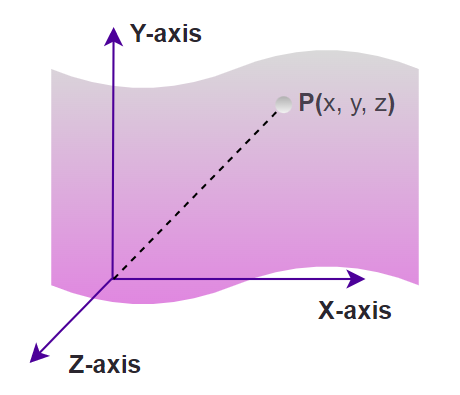
|
|
Points, Lines, and Planes are basic terms used in Geometry that have a specific meaning and are used to define the basis of geometry. We define a point as a location in 3-D or 2-D space that is represented using the coordinates. We define a line as a geometrical figure that is extended in both directions to infinity. Similarly, a plane is defined as the collection of all such lines, i.e. it is a 3-D space on which the line passes. In this article, we will learn about Points, Lines, and Planes in detail including their solved examples and problems based on them. Table of Content
Points, Lines, and Planes in GeometryIn basic geometry, fundamental concepts like points, lines, and planes form the foundation upon which more complex geometric ideas are built. Points are precise locations in space, devoid of size or dimension, represented simply by dots. Lines are infinite paths stretching in two opposite directions, composed of an unending series of points. They are defined by any two distinct points lying on them. Beyond lines, planes extend infinitely in all directions, forming flat, two-dimensional surfaces. A plane can be defined by any three non-collinear points or by a line and a point not on the line. These basic elements serve as the starting point for exploring the intricacies of geometric shapes, relationships, and constructions. What is a Point?A Point in geometry is defined as a location in the space that is uniquely determined by an ordered triplet (x, y, z) where x, y, & z are the distances of the point from the X-axis, Y-axis, and Z-axis respectively in the 3-Dimensions and is defined by ordered pair (x, y) in the 2-Dimensions where, x and y are the distances of the point from the X-axis, and Y-axis, respectively. It is represented using the dot and is named using capital English alphabets. The figure added below shows a point P in the 3-D at a distance of x, y, and z from the X-axis, Y-axis, and Z-axis respectively. [/caption]Collinear and Non-Collinear PointsWhen 3 or more points are present on the straight line then such types of points as known as Collinear points and if these points do not present on the same line, then such types of points are known as non-collinear points.  Coplanar and Non-Coplanar PointsWhen the group of points is present on the same plane then such types of points are known as coplanar points and if these points do not present on the same plane, then such types of points are known as non-coplanar points.  What is a Line?A Line in three-dimensional geometry is defined as a set of points in 3D that extends infinitely in both directions It is the smallest distance between any two points either in 2-D or 3-D space. We represent a line with L and in 3-D space, a line is given using the equation,
In 3D we can also form a line by the intersection of two non-parallel planes. 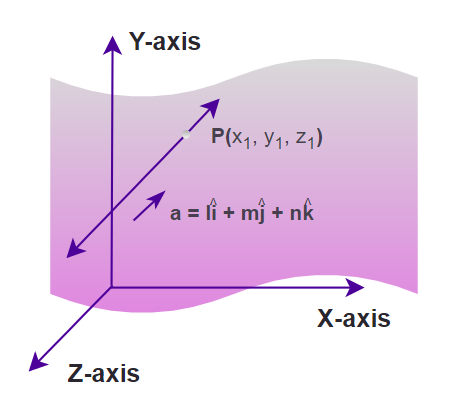 Points, Lines, and Planes Line SegmentA line segment is defined as the finite length of the line that is used to join two points in 2-D and 3-D. It is the shortest distance between two points. A line segment between two points A and B is denoted as, AB 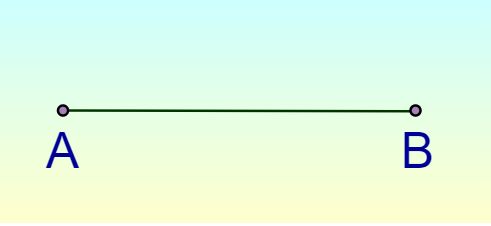 A line has infinite length whereas a line segment is a part of a line and has finite length. Mid-PointMidpoint is defined as the point on the line segment which divides the line segment into two equal parts. Suppose we have two points A and B and the line segment joining these two points is AB and not the point P on the line is called the midpoint if it breaks the line into two equal parts such that, AP = PB Thus, P is called the midpoint of line segment AB. The image added below shows the line segment AB with P as the midpoint. 
RaysA ray is defined as a line that has a fixed end point in one direction but can be extended to infinity in the other direction. It is of infinite length. We define the ray joining points O and A and extending to infinity towards A as  Intersecting and Parallel linesIn 2-D any two lines can either meet at some point or they never meet at some point. The lines that meet at some point are called intersecting lines. The distance between the intersecting line keeps on decreasing as we move toward the point of intersection, and at the point of intersection of these lines, the distance between them becomes zero. When two lines intersect an angle is formed between them. Two lines that never meet each other in 2-D planes are called parallel lines. For parallel lines, the distance between them is always constant. The images below show Intersecting and Parallel lines. 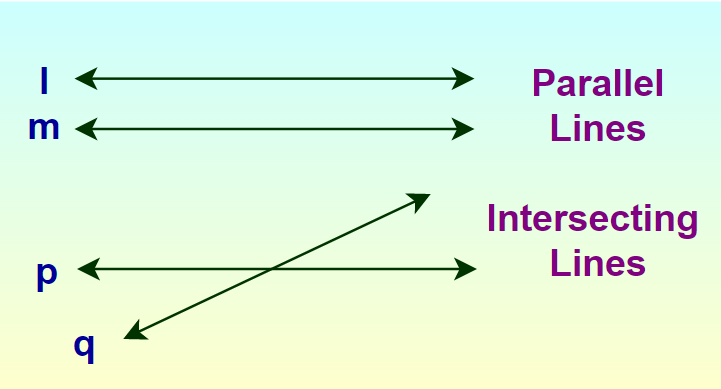 Perpendicular LinesIntersecting lines that intersect at right angles are called perpendicular lines. The angle between these perpendicular lines is always the right angle or 90 degrees. The perpendicular lines are shown in the image added below: 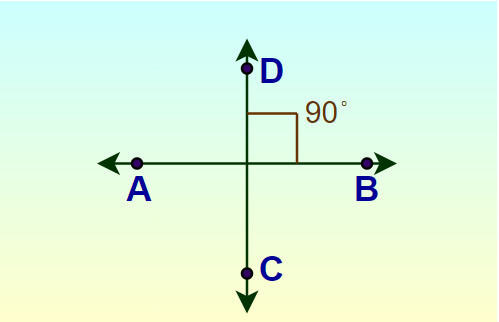 What is a Plane?A Plane in three-dimensional (3D) geometry is a surface such that the line segment joining any two points lies completely on it. It is the collection of all the points and can be extended infinitely in any of the two dimensions. The general form of a plane in 3D is a first-degree equation in x, y, z i.e. We represent a plane in 3-D as,
A plane has only two dimensions length and breadth and it can be infinitely stretched in these two dimensions. 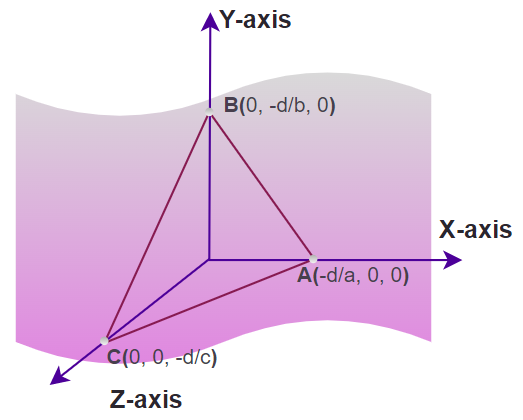
SolidA solid is a 3-D concept we also called, space. We defined the solid as the extended plane that has three dimensions length breadth and height. A solid can be extended infinitely to incorporate all the space in 3-D. Vector Form of Equation of Plane in Normal FormThe vector form of the equation of a plane in normal form is given by:
Note: The vector equation of the plane in the form [Tex]({\vec {r}} . {\vec{n}} = d) [/Tex] is said to be in the normal form only when [Tex]{\vec {n}} [/Tex]is a unit vector normal to the plane and d is the distance of the plane from the origin. If [Tex]{\vec {n}} [/Tex] is not a unit vector then we have to divide the above equation by [Tex] |{\vec{n}}| [/Tex] on both sides in order to convert it into the normal form. [Tex]{\vec {r}}.({\vec{n}}/|{\vec{n}}|) = d/|{\vec{n}}| or {\vec{r}}.n̂ = d/{\vec {|n|}} [/Tex]. This can be understood with the help of the example discussed below, Example: The vector equation of the plane in 3D space which is at a distance of 8 units from the origin and normal to the vector (2 i+ j + 2 k) is given by? Solution:
Cartesian Form of Equation of a Plane in Normal FormThe cartesian form of the equation of a plane in normal form is given by:
If a, b, and c are not the direction cosines of the normal to the plane then we have to follow these steps:
After applying these steps the coefficients of x, y, and z on the LHS will become the direction cosines of the normal to the plane, and the constant term on the RHS will become the distance of the plane from the origin. Example: A plane in the 3D space is represented by (2x + y + 2z – 24 = 0) then the cartesian equation of this plane in the normal form is given by. Solution:
Distance of a Point from a Plane in Cartesian FormThe distance of a point P (xo, yo, zo) from a plane π: (a x + b y + c z +d = 0) in the cartesian form is defined as the length (L) of the perpendicular drawn from that point to the plane. That is calculated using the formula,
Now let’s look at the example to know more. Example: Find the distance of the point (2, 1, 0) from the plane (2 x + y + 2 z + 5 = 0). Solution:
Distance of a Point from a Plane in Vector FormThe distance of a point P having position vector [Tex]{\vec {a}} [/Tex]from a plane π: [Tex]{\vec {r}}.{\vec {n}} = d [/Tex] in vector form is defined as the length (L) of the perpendicular drawn from that point to the plane.
Example: The distance of a point with position vector (2 i + j + 0 k) from the plane [Tex]{\vec {r}} [/Tex] . (2 i + j + 2 k) = 5 is given by? Solution:
People Also Read:Points, Lines, and Planes Solved ExamplesExample 1: The vector equation of the plane in 3D space which is at a distance of 5 units from the origin and normal to the vector (4 i+ 3 k) is given by? Solution:
Example 2: Find the distance of the point (0, 1, 0) from the plane (3 y + 4 z = 7). Solution:
Example 3: Find the distance of a point (5, 3, 0) from the plane [Tex]{\vec {r}} [/Tex]. ( 4i + 3j) = 8. Solution:
Example 4: Find the distance between points, (2, 4) and (5, 6). Solution:
Points, Lines and Planes Worksheet
Points, Lines, and Planes – FAQsWhat is Geometry?
What is a Point?
What is a Line?
What is a Plane?
What is a Space?
|
Reffered: https://www.geeksforgeeks.org
| Class 12 |
Type: | Geek |
Category: | Coding |
Sub Category: | Tutorial |
Uploaded by: | Admin |
Views: | 11 |